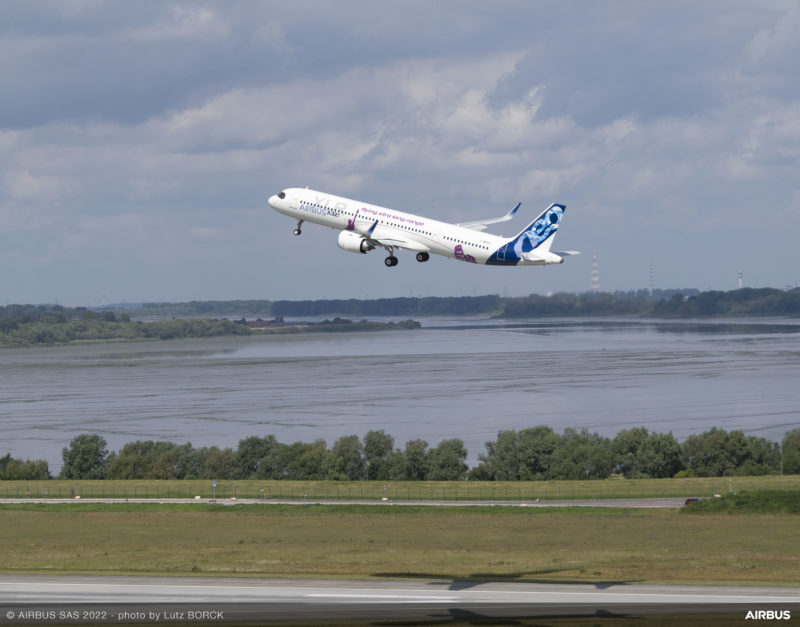It seems that having the right product for the right segment is a way to obtain business, with Icelandair planning its fleet renewal. And in this case, it’s turned to Airbus instead of Boeing.

Airbus A321XLR first flight – Image, Airbus.
Icelandair and Airbus have signed a Memorandum of Understanding for the purchase of 13 Airbus A321XLR aircraft with purchase rights for additional 12 aircraft.
The aircraft deliveries will start in 2029.
Icelandair, however, plans to start operating Airbus aircraft in 2025 and is currently in an advanced stage of negotiations in relation to four leased Airbus A321LR for that purpose.
The airline notes that Further additions can be expected in the years thereafter.
The move will allow Icelandair to retire the existing Boeing 757-200s, which have been the backbone of the Icelandair fleet.
For Icelandair, there are some big benefits in the configuration they are choosing to deliver – with them targeting a 190-seat count on its A321XLR/LR aircraft. This compares with the Boeing 757-200, which can hold 183 passengers, whereas the 737 MAX 8 and the 737 MAX 9 have passenger capacities of 160 and 178.
The A321LR and A321XLR seem to be good fits in the Icelandair network, with the A321LR being able to fly up to 4,000 nautical miles (fitting in with the range of the network), Meanwhile, the A321XLR has a range of up to 4,700 nautical miles, allowing Icelandair to operate it on its long-range destinations with opportunities to enter new markets.
Trying to keep Boeing happy.
According to Icelandland, the Boeing 757,767 and 737 MAX aircraft will continue to be important for Icelandair’s operations in the coming years.
Until 2025, Icelandair will continue to operate a full Boeing fleet but following the first deliveries from Airbus, the Company will operate a mixed fleet of Airbus and Boeing aircraft.
In Quotes
Bogi Nils Bogason, President & CEO of Icelandair said
“We are happy to announce that we have now reached a conclusion regarding Icelandair’s future fleet. We have decided that the capable and fuel-efficient Airbus aircraft, A321XLR and A321LR, will become the successors of the Boeing 757 we are gradually retiring. The Boeing 757 has been the cornerstone of Icelandair’s operations since 1990. Its unique capabilities have underpinned the successful development of our extensive route network and competitive transatlantic hub by leveraging Iceland’s unique geographical location to connect North America and Europe via Iceland. The excellent Airbus aircraft will not only allow us to further develop our proven business model around transatlantic flights but also open opportunities for future growth by entering new and exciting markets.”
In Boeing HQ, there will be more than a few questions to answer.
This is going to sting – from an All-Boeing operator for its main fleet to up sticks and switch to a competitor’s product.
Whilst Boeing could have competed on price to an extent (and considering the airline took delivery of a 737 MAX in 2022), it couldn’t compete where it needed to – the required range to meet the Middle of the Market.
That sweet Middle-of-the-Market is key to some airlines and their operations – and it allowed airlines like Icelandair to launch services, as well as some airlines to offer thin and narrow routes where a wide-bodied aircraft would not be economical to serve the route (and if we look at the order book so far, airlines have been clamouring for an aircraft like this to fill that gap).
And Boeing hasn’t got an answer to that in its 737 Family right now – if it likes to admit it or not.
Whilst there will be some consolation that Icelandair plans to operate a mixed fleet – that will in the long term eat into the airline’s economics and how it operates.
And that could be the thing to watch – as Icelandair starts to transition away from Boeing products.
Welcome to Economy Class and Beyond. Your no-nonsense guide to network news, honest reviews, in-depth coverage, unique research, as well as the humour and madness I only know how to deliver.
Follow me on Twitter at @EconomyBeyond for the latest updates, as well as Mastodon too! You can follow me on Instagram too!
Also, remember that we are part of the BoardingArea community, bringing you the latest frequent flyer news from around the world.
How right you are! The debacle known as the 737-MAX at Boeing HQ will yield financial and reputational debits for decades. Demand for the successor to the 757 was/is so great that, when Boeing announced its New Midsize Airplane (NMA) project, Delta stationed personnel at Boeing in aid of being the launch customer for the aircraft, once complete. MCO is my home airport and I routinely see Iceland Air 757 birds in the northeast corner of the airfield when not in use (easily visible from B52 Park for those who know how to find it) and long have wondered as to the airline’s long-term plans. The 737-MAX8 and -MAX9 seem to work well enough but, as you raise in your post, miss the mark on the ideal balance between range and capacity. Having bungled the MAX project this badly, I feel the Boeing deserves to lose one of its exclusive customers (and I’m a patriotic American). Readers interested in learning more about the NMA 797 project should peruse https://en.wikipedia.org/wiki/Boeing_New_Midsize_Airplane